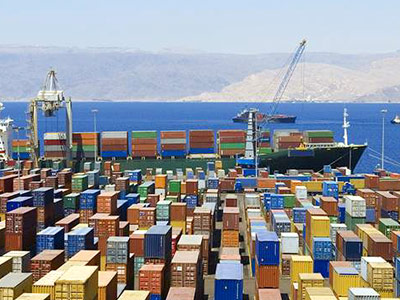
Australia’ geographical separation is a great advantage when it comes to protecting our land from foreign animals, plants, and diseases. While an illness may spread freely through the countries of Europe, Australia is isolated, making it harder for biological threats to reach us. Our geographical isolation, however, is not enough to keep our flora and fauna protected from invasive species introduced by human activity.
To prevent the accidental introduction of an invasive species, some imported products and shipping containers are processed at an Australian Quarantine and Inspection Service (AQIS) approved premises – known as a Quarantine Approved Premises, or QAP. Once all AQIS requirements have been met, the goods are allowed to enter the country.
Various imported goods are subject to different AQIS requirements. Given that the legislation concerning AQIS sites is complex and extensive, it is advised businesses contact a AQIS specialist such as Cleanawater to ensure the premises meet the legislation.
To prevent the accidental introduction of an invasive species, some imported products and shipping containers need to be processed at a Quarantine Approved Premises (QAP).
Cleanawater can develop tailored AQIS and water authority compliant water treatment and recycling systems for quarantine sensitive business operations. Our all-in-one systems can ensure that a business avoids fines, reduce costs and help keep Australian ecosystems protected from invasive species.
Contact Cleanawater on 1800 353 788 to find out how our team can help your business.
Key Features of Cleanawater AQIS Solutions
- Skid mounted, pre-plumbed and pre-wired for easy and fast installation
- AQIS compliant oil water separators and filters
- pH sampling and correction systems
- Fully automated systems
- Optional combinations with First Flush Diversion Systems and Water Recycling Systems
- Optional advanced alarm systems
Find out more about Cleanawaters AQIS solutions.
Industry Examples
Unroofed QAP Wash Bay
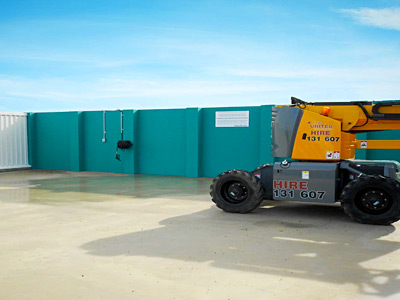
A business wishes to replace their current AQIS system at their Class 1.1 Quarantine Approved Premises (QAP). The QAP processes goods shipped in large containers, as well as machinery and other large items, in an open, unroofed wash bay. The business wishes to keep this area unroofed in order to continue using forklifts for moving and packing these large items.
Solution
Cleanawater’s AQIS system with First Flush Diversion System
As the wash down bay is over 20 square meters in area and unroofed, the business will require a first flush diversion system with rain gauge in addition to an oily water separator and 100 micron treatmentsystem. It is also recommended that the AQIS system includes a silt trap to protect the system from rubbish and debris.
QAP Processing Facility
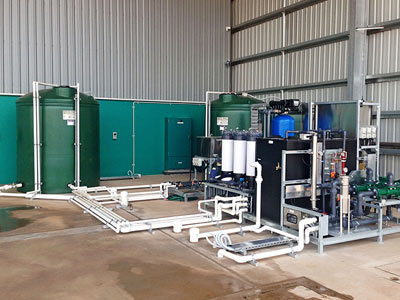
The management of a medium-size QAP (Class 2.1) business commissions the development of an AQIS System and a Water Recycling System. The wash bay is roofed as the items processed at the facility are relatively small. The business has limited space and operates 24/7, so it is important that the system takes up a small area and is equipped with alarms to alert HQ of any emergency faults.
Solution
Cleanawater’s AQIS System with a Water Recycling System
The AQIS system ensures that the business is compliant with quarantine regulation, and the addition of a water recycling system allows the business to track flow rates, water quality and storage levels remotely.
Since the wash bay is small and roofed, there is no need for a first flush diversion system. However, it is highly recommended that an AQIS system has a silt trap to protect the system from excessive debris. As an additional safety measure, the system should also be equipped with a high-level alarm.
The need for AQIS systems
In the past, introduced species have proven to be extremely detrimental to native Australian species and their ecosystems. Take, for example, the introduction of the European Carp to Australia in the mid-1800s; the species is now a widespread pest found across Australian waterways (Koehn, 2004). The prevalence of this pest has had a detrimental effect on freshwater ecosystems – particularly as a result of the increased levels of water turbidity, due to the species' behaviour of uprooting aquatic plants in search of food (Pinto et al., 2005).
Today, strict legislation plays a crucial role in preventing the deliberate introduction of a foreign species into Australian ecosystems. However, despite these laws, our borders are not immune from small insects and seeds that may accidentally reach our shores from imported goods. To ensure imported goods are thoroughly examined prior to distribution, all items are required to be inspected at a Quarantine Approved Premises (QAP).
Imported items and their containers must be cleaned to eliminate any soil or sediment that may have adhered to surfaces...
Not all goods are considered to be of equal risk, however. Different imports pose varying levels of biosecurity threats; for instance, a live animal is more likely to bring insects into the country than imported plastic containers, and it would not be feasible to examine both animals and plastic containers at the same QAP. Therefore, QAPs are classified by 'Classes', each with their own set of regulation requirements.
Imported items and their containers must be cleaned to eliminate any soil or sediment that may have adhered to surfaces, and all cleaning of imported objects has to be carried out at AQIS compliant wash down bays within QAPs.
Cleanawaters’ AQIS systems work by removing sediment and seeds from water used to wash imported goods. The filtering media in which sediment, seeds and soil are trapped is then incinerated. A large number of businesses combine their AQIS system with a water recycling system for a complete water treatment and recycling solution.
The operation of a typical AQIS system
Splash Walls
The use of high-pressure hoses is common in commercial wash down bays. Although they are a useful tool in washing operations, they also increase the likelihood of water escaping the confines of the wash down bay. This displaced water can lead to harmful particles, such as a seed of an invasive species, leaving the QAP and pose as a risk to the environment.
The height of the walls around a wash down bay (called splash walls) are regulated by the AQIS to eliminate the risk of spreading harmful particles outside the QAP. These heights are determined on the basis of risk. For example, a large agricultural machine is considered higher quarantine risk than a container carrying personal items. Therefore, splash walls surrounding agricultural machinery are required to be constructed higher.
There is one requirement, however, that is consistent across all QAP classes: no waste water is to be discharged to stormwater or sewerage prior to treatment. The required level of treatment in an AQIS system may vary from simple filtration to a complete water treatment and recycling system.
No waste water is to be discharged from a Quarantine Approved Premises to stormwater or sewerage prior to treatment.
Silt Traps
QAP regulation states all water in wash down bays must drain to a central grate. Typically, for wash bays where a large amount of sediment is expected, water drains into a 'silt trap'. A silt trap is a small pit that filters runoff in four steps:
- A grate stops general debris and rubbish from entering the pit
- A collection basket stops large silt from entering the system
- Fine silt and sludge settles at the bottom of the pit
- The collected waste is disposed of in accordance with the AQIS regulations.
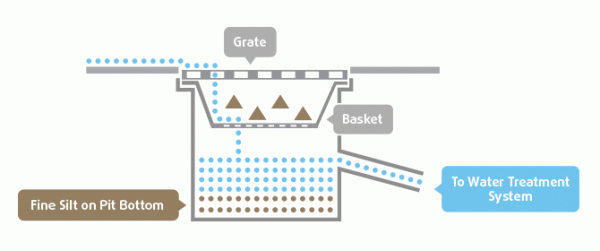
Using silt traps is always recommended as they offer great protection for an AQIS system against rubbish and other elements that may damage components or clog pipes. Silt traps are a low cost and low maintenance measure which allows a business the flexibility to process goods at any time.
Flowing into the Collection Pit
Water from the silt trap flows into a collection pit via a high-density polyethylene pipe. The grading of this piping, represented as a ratio, is regulated by the Australian and New Zealand Plumbing Standards and will vary depending on the diameter nominal (DN) of the pipe.

This value is a ratio of the required vertical distance between the silt trap (A) and the collection pit (B), and the required horizontal distance for a drain pipe.
Given a DN100 pipe, the slope of this piping should be regulated at a ratio of 1:60, or 1.65%, according to the Standard AS/NZS 3500.2:2003.
This ratio means that for every one meter of drop between the silt trap output and the input of the collection pit (vertical distance), there should be at least 60 meters of horizontal distance between the silt trap output and the input of the collection pit.
If the slope is too steep, water will flow too quickly and create a vacuum and gurgling effect. Conversely, if the slope is not steep enough, the water will flow too slowly, allowing sediment to settle and increase the risk of blockages (Mays,1999).
Inside the Collection Pit
There are two float switches in the collection pit:
- A ‘start float switch’ determines whether there is enough water to start evacuating the system via an oily water separator and 100 micron filter.
- A ‘high-level float’ switch alerts the operator when the pit is close to reaching its maximum capacity or if a potential fault has occured.
The high-level float switch doubles as a backup switch; if the control cabinet detects that the high-level float switch is on, but the start float switch is off, then this may be an indication that the start float switch may be defective.
Once there is enough water in the collection pit, the start float switch sends a signal to the control cabinet, which in turn sends a signal to the pump indicating there’s enough water to start the system. The minimum amount of water necessary to start the system is also known as 'working volume' and is typically the same as the required flow rate. For instance, if the system's flow rate is 1000 L/h, the minimum amount of water required in the collection pit will be 1000L.
The collection pit has an access point at the top of the pit. This allows the installation of devices, such as the foot strainer and the float switches, and allows the pit to be cleaned when needed. AQIS regulations state that the access point must always be closed unless maintenance is underway.
Water from the collection pit is drawn by the pump through a 50mm diameter pressure pipe. A foot strainer valve is fitted to the pipe's intake port located in the collection pit. This valve serves two functions; it ensures the pump never runs dry, and it stops large waste from entering the system. Foot strainer valves are available in a range of materials for a broad range of fluid types.
Appropriate transportation of water from the collection pit to the oil water separator is crucial for the treatment system. Emulsification can occur when a suspension of oil and water is agitated or forcefully disrupted. The use of high-speed pumps can be such a source of agitation. Emulsified oil and water make the separation process more complex and costly. To avoid emulsification, non-emulsifying pumps such as Progressive Cavity pumps or Diaphragm pumps are used. These low-speed pumps gently transport water from the collection tank to the oil water separator and are designed to handle large concentrations of oil in water.
Oil Water Separator
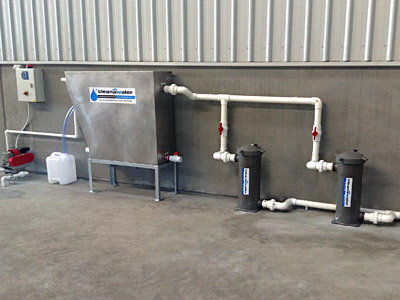
The separation process begins once water enters the oil water separator. The separator works using simple principles of gravity; water is a dense fluid and will sink to the bottom of the tank, whereas oil is a less dense fluid and floats towards the top. The water can then be easily discharged to a filtration system for further refinement while the oil can be extracted and fed into a waste oil drum. For an AQIS system, the legislation states that water must be filtered to a minimum of 100 microns. The used filtering media is to be disposed of as quarantine waste and will be typically buried or incinerated.
Although the water has been treated to AQIS standards, it must also meet local water authority requirements. Filtering may be the last phase of both AQIS and water authority's requirements, however, more steps may be required in order to achieve water authority compliance if the water's quality is poor. In some scenarios, an AQIS system must be used in conjunction with a First Flush Diversion System to achieve water authority compliance.
First Flush Diversion System
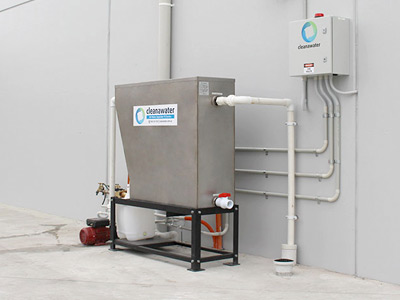
In a rain event, stormwater diversion systems direct potentially harmful rainwater towards the AQIS system, but allow clean rainwater to be discharged to stormwater. This ensures that high-risk water is treated and sewer systems are not unnecessarily congested.
Legislation regarding the need for this device varies from one water authority to another. Generally speaking, an unroofed wash down bay over 20 square meters will require a First Flush Diversion System. In some cases, installing a roof over the area may be an alternative option. However, in many applications a roof may not be practical or compatible with operation requirements. Installing a roof is also significantly more expensive than installing a First Flush Diversion System.
The stormwater diversion valve is located inside the silt trap. Usually, a stormwater diversion valve is combined with a rain gauge for more accurate results. The rain gauge has a small tip bucket of 0.2mm capacity supported on a hinge. A pulse is sent to the control cabinet when the tip bucket becomes full and empties. If the rain gauge detects 10mm of water the control cabinet shuts down the first flush diversion valve, allowing any excess rainwater to be discharged to stormwater.
Recycling of water at Quarantine Approved Premises
QAPs that use a large amount of water in during operations will benefit from installing a water recycling system on their premises. Cleanawater’s Water Recycling Systems are easily coupled with AQIS systems, to create an all-in-one water treatment and recycling solution.
The regulatory compliance of Water Recycling Systems is enforced by AQIS and the relevant local water authority. Once water has been filtered to 100 microns, as per AQIS requirements, the water must then be tested in a retention vessel to ensure pH levels of between 5.0 and 7.0. This is because highly acidic substances can cause considerable damage to components in pumping stations while alkaline substances can minimise the effectiveness of water treatment processes. As such, water authorities require businesses to ensure safe pH levels prior to discharge. The filtered water is then taken to a pit known as the recycled water pit. Here, chlorine is added to achieve a concentration of 2ppm.
Water is subsequently pumped into a batch tank. This batch tank is equipped with a water mixer or agitator, as well as a pH controller which is capable of measuring the amount of free and total chlorine residual. Once water enters this tank the following steps take place:
- Chlorine is added to achieve 200ppm
- Water is mechanically agitated for 10 minutes
- Treated water is held in the process tank for at least 1 hour
- After one hour, water is tested to ensure a minimum final concentration of chlorine of 5ppm
- If concentration of chlorine is less than 5ppm, repeat steps 1-3.
Due to the high concentration of Chlorine added to achieve 200ppm, the final concentration is much higher than 5ppm. Usually this value ranges between 100-120ppm, however, when water is rich in sediment despite the filtration stage, sediment will absorb chlorine, thus making it possible for water to not achieve 5ppm.
When water has achieved a final concentration of 5ppm, all AQIS requirements have been met. There are, however, more water authority requirements that must be met prior to discharge or reuse. For example, it may be required that water discharged to the sewerage system has a pH between 7-10. In these instances, water from the batch tank is pumped to a holding tank where it is treated with neutralising chemicals to achieve the required pH levels. Once water meets water authority’s pH level requirements, water is safe to be discharged or reused.
References
Koehn, J. D. (2004). Carp (Cyprinus carpio) as a powerful invader in Australian waterways. Freshwater biology, 49(7), 882-894.
Pinto, L., Chandrasena, N., Pera, J., Hawkins, P., Eccles, D., & Sim, R. (2005). Managing invasive carp (Cyprinus carpio L.) for habitat enhancement at Botany Wetlands, Australia. Aquatic Conservation: Marine and Freshwater Ecosystems, 15(5), 447-462.
Mays, LW 1999, Water Distribution Systems Handbook, n.p.: London : McGraw-Hill, 1999.
Must Read
What to Expect During a Modular Wash Bay Installation
CleanaWater, we make the process of installing a modular wash bay on your site as smooth and straightforward as possible. ...
Read moreThe CleanaWater Team Driving Water Treatment and Sustainability
CleanaWater is powered by a dedicated team of professionals who bring expertise and passion to every project. ...
Read more